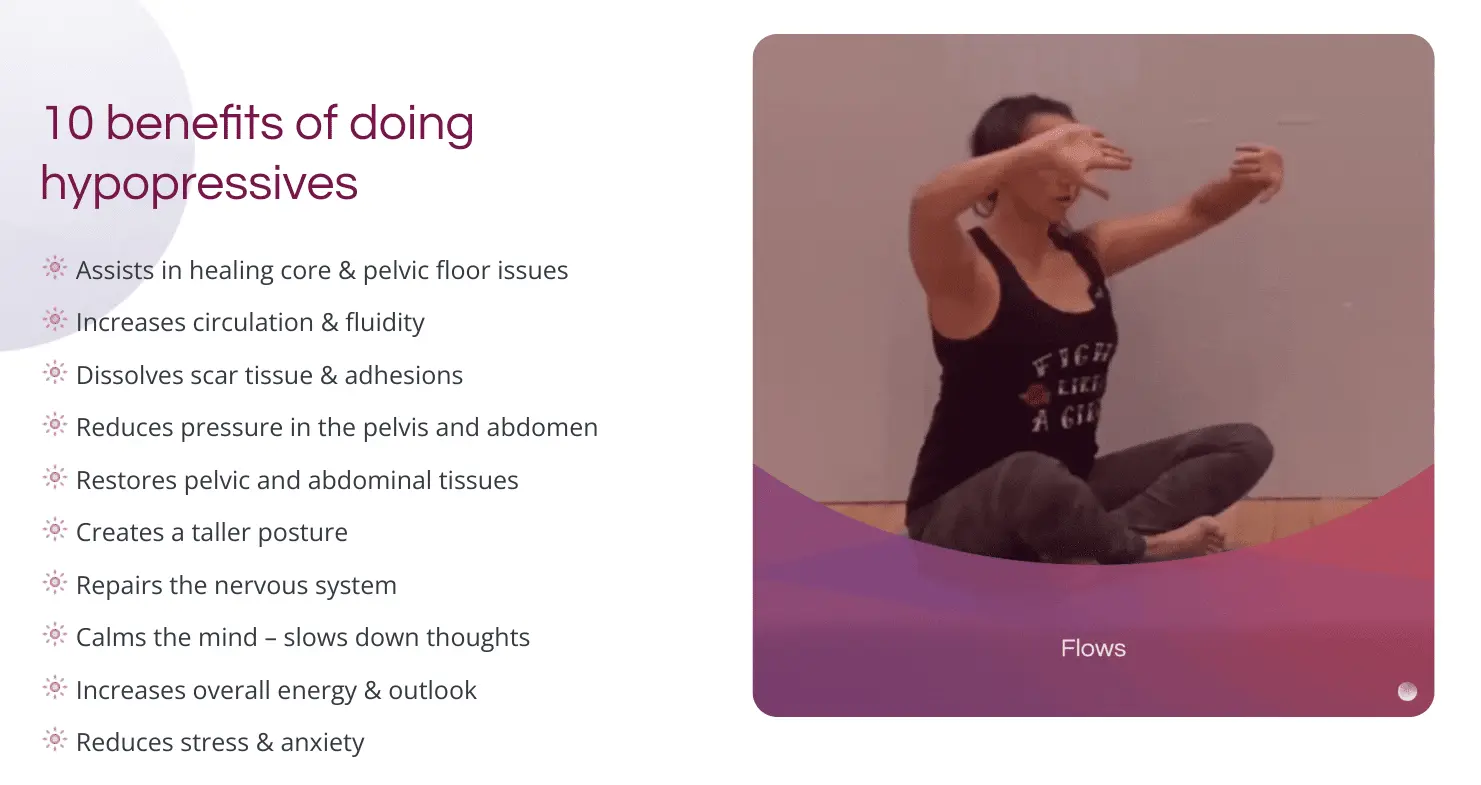What Is Pelvic Organ Prolapse and the Best Treatment for It?
- June 9, 2022
- Pelvic Floor

After having a baby and being reviewed in the postnatal checkup, women are often told that things are back in their original place and they can resume the lifestyle they had prior to pregnancy.
Nonetheless, they may not be “back to normal.” For a considerable amount of women, the baby isn’t the only thing coming out of their vaginas. Now, it’s their internal organs. A.k.a. pelvic organ prolapse. So, pelvic organ prolapse treatment becomes an important topic.
Let’s take a look at a few facts about pelvic organ prolapse and what you can do if you have it. Spoiler (a good one): you don’t need to go through surgery, deal with pessaries, or do Kegels.
What Is Pelvic Organ Prolapse?
Pelvic organ prolapse or POP for short is a form of pelvic floor dysfunction. It happens when the pelvic floor muscles and tissues weaken to a point when they are no longer able to provide adequate support for the pelvic organs.
As a result, one or more pelvic organs get pulled into the vagina or the rectum creating a bulge, also known as a hernia.
How common is pelvic organ prolapse?
Like most pelvic floor disorders, it’s more common than many are aware. Statistically, approximately a quarter of all women suffer from pelvic organ prolapse. The number increases to about 50% for women who have reached the age of 80.
This means that out of every four women you meet in your day-to-day life, at least one has likely experienced prolapse. This is an alarming frequency.
There are different forms of pelvic organ prolapse depending on which organs it affects:
• Cystocele – when the bladder is pulled into the vagina.
• Enterocele – when the small intestine gets pulled into the vagina.
• Rectocele – when the rectum gets pulled into the vagina.
• Rectal prolapse – when the rectum turns inside out and is pulled through the rectal opening, resembling a big hemorrhoid.
• Uterine prolapse – when the uterus is pulled into the vagina.
• Vaginal vault prolapse – when the cervix and the top part of the vagina lose support and collapse into the vaginal canal or outside the vagina.
This can occur after hysterectomy, surgical removal of the uterus. Since the uterus provides support for the top part of the vagina, removing it also removes this support. As a result, it can be easily pulled out of its usual place.
There are instances when a woman may experience more than one of these at the same time.
What Causes Prolapse?
The pelvic floor is a strong and resilient structure that shapes the bottom section of the abdominal-pelvic cavity. It’s designed to provide sufficient support for the pelvic organs – the uterus, bladder, and rectum.
However, as life unfolds, the pelvic floor muscles and tissues can weaken or withstand damage or injury. Or, they may become too tense and rigid to be able to relax properly which can also lead to weakening and damage.
Pregnancy and childbirth is the leading contributing cause to women developing prolapse. The risk of prolapse increases if a woman has had a long and strenuous labor or instrumental delivery.
However, childbirth is not the only reason why this may happen. Other reasons include:
• Menopause – decreased levels of estrogen lower the amount of collagen, which causes muscles and tissues to loosen.
• Chronic constipation – this results in straining and pushing that places repeated excess pressure on the pelvic floor.
• Allergies and chronic coughing due to lung disease or smoking – every time we cough and sneeze the pressure on the pelvic floor increases. This can cause damage overtime if the pelvic floor is not strengthened and its functionality is not improved.
• Excess weight – weight-related issues such as obesity put continuous strain on the pelvic floor.
• Pelvic surgery such as hysterectomy – this forms scar tissue which can impair pelvic floor functionality and can reduce the support that other pelvic organs receive.
• Levator ani injury – levator ani is a broad pelvic muscle and tissue group that provides support to the bladder and other organs.
Repeatedly holding urine and stool, experiencing injury due to childbirth or sexual trauma, strenuous labor, or instrumental delivery can cause injury of the levator ani tissues. The area becomes tense due to scar tissue development, and this frequently contributes to the development of incontinence and pelvic organ prolapse.
Symptoms of Pelvic Organ Prolapse
Many women feel as if their prolapse occurred suddenly, as if out of nowhere. But, it’s not actually true. In most cases, prolapse takes time to develop. It can take months or even years.
Many women may not experience any symptoms of pelvic organ prolapse until it becomes more severe. Meanwhile, others believe that it’s simply a postpartum symptom that is normal, especially if their pelvic organ prolapse symptoms are mild.
Yet, there is nothing normal about prolapse, and you shouldn’t suffer when you can heal. Moreover, without severe medical intervention. You can heal holistically with natural pelvic organ prolapse treatment methods.
But first, what does prolapse feel like? How to tell if you have pelvic organ prolapse that you should start addressing and seeking treatment for ASAP?
Depending on the state of the prolapse, your pelvic organ prolapse symptoms can vary in nature and intensity.
The most common of the pelvic organ prolapse symptoms are feelings of heaviness, pulling, or pressure in the vagina. You may feel like something is about to fall out. This is due to the pelvic organs pressing against the vaginal walls.
In addition to that, you may also experience:
• feeling like you have something resembling a golf ball in the vagina, especially after you lean or squat down to pick something heavy like your baby,
• pressure on the bladder and a constant feeling of needing to go,
• incontinence,
• painful sex that may be accompanied with bleeding,
• bleeding or spotting from the vagina,
• constipation or having a hard time to empty the bowels,
• wideness of the vaginal opening or vaginal laxity,
• inexplicable lower back pain.
Pelvic Organ Prolapse Stages
There are four stages of pelvic organ prolapse depending on its severity. Stage 1 is the mildest form with no or few symptoms whereas stage 4 is the most severe.
Sometimes, you may also see Stage 0 outlined. That’s when a woman has no prolapse symptoms.
Let’s take a look at each of the four stages of pelvic organ prolapse in more detail.
Stage1 Pelvic Organ Prolapse
During stage 1, prolapse is mild. The affected organ or organs are being pulled into the vagina, but are still supported by the pelvic floor. In most cases, women do not experience any symptoms and are unaware that they are developing prolapse.
Stage 2 Pelvic Organ Prolapse
Stage 2 is moderate in severity. It’s when most women typically start experiencing pelvic organ prolapse symptoms. The organ or organs are being pulled into the vagina, but aren’t yet going past the vaginal opening. They are still inside the vagina.
Stage 3 Pelvic Organ Prolapse
Stage 3 pelvic organ prolapse is a severe state of the condition. Pelvic organs are pulled through the vaginal opening, and you will be able to see a bulge protruding outside your vagina.
Stage 4 Pelvic Organ prolapse
During this stage, the organ has been completely pulled through the vaginal opening. Medically, it’s called vaginal eversion, meaning that the vagina has turned inside out.
Pelvic Organ Prolapse Treatment:
What Doesn’t Work
Some of the most common treatment methods for pelvic organ prolapse include strengthening the pelvic floor with Kegels or using pessaries. Pessaries are soft and flexible prosthetic devices that are inserted inside the vagina to keep the organs in place. In more severe cases, doctors can recommend surgery.
Despite their widespread use, these pelvic organ prolapse treatment methods resemble Band-Aids more than they provide a long-term solution. Kegels can make prolapse worse. While pessaries on the other hand, are often touted as effective, for short term relief.
Nonetheless, they do not address the root cause of the issues – weak and tense pelvic floor muscles and tissues.
Meanwhile surgery forms additional scar tissue, which can lead to even more tightness and weakness of the pelvic floor, make incontinence unbearable, and cause other pelvic issues.
Sounds far from being effective, doesn’t it?
How to Prevent and Treat Pelvic Organ Prolapse Naturally
There are, however, effective non-invasive approaches that can heal and reverse pelvic organ prolapse. With a dedicated natural pelvic organ prolapse treatment routine, you can even end up feeling better than you ever did.
So, what can you do? Below are some of the alternative natural pelvic organ prolapse treatment methods that you can benefit from.
1. Lifestyle and Diet Changes
The first thing you can do to help your body heal is by providing it with essential nutrients that support the healing process and avoiding anything that could possibly worsen your prolapse.
Beneficial changes include:
• Eating a diet rich in fiber that promotes easy bowel movements.
• Drinking plenty of water to prevent constipation.
• Including probiotics such as fermented foods that prevent constipation and facilitate bowel movements.
• Taking collagen supplements or drinking bone broth to support your body’s collagen production that can help heal damaged tissues and improve their elasticity.
• Avoiding inflammatory foods like dairy, processed and sugary foods, caffeine, and alcohol, which could slow down the healing process.
• Avoiding straining and pushing when emptying bowels.
• Taking short bathroom breaks.
• Quitting smoking.
• Exercising and managing your weight to reduce the strain on the pelvic floor.
• Managing stress and anxiety which can tense and further weaken your pelvic floor.
• Maintain a proper posture while sitting and standing so that other muscles in your body help support the pelvic floor.
2. Hypopressives
Kegels generally do very little or nothing to prevent or heal prolapse. In fact, Kegels can actually worsen prolapse by creating more tension in the pelvic floor. That’s because the exercises create pressure in the abdominal cavity. If the pelvic area is already tense, Kegels and most other forms of exercise will create even more tension.
Instead, opt for routines that aim to reduce pressure in the abdomen. This is exactly what the hypopressive method does. It not only reduces the pressure providing immediate relief but also helps to gently tone and retrain the pelvic floor and the core. As a result, it can regain its ability to provide the support that your pelvic organs need.
Watch this on how Hypopressives can heal prolapse and connect to the abs
3. Scar Tissue Remediation
If you have suffered injuries during childbirth, your pelvic floor carries scars. Scar tissue is less elastic and mobile than the original tissues. Therefore, it can cause your pelvic floor to tighten and weaken.
Scar tissue remediation is an approach that involves massage and other techniques that help improve the elasticity and functionality of the pelvic muscles and tissues.
4. Pelvic Floor Therapy
An experienced holistic pelvic floor therapist can provide a personalized approach to improving your specific condition. If your pelvic floor is weak, your therapist may recommend techniques and exercises to strengthen it. If, on the contrary, it’s too tight, they are going to recommend treatment options to relax it so that it can become more reflexive.
Do these pelvic organ prolapse treatment methods sound better than Kegels, pessaries, and surgery?
I have amazing news!
There is a lot more you can do to improve your pelvic health and heal prolapse naturally.
Heal Prolapse Holistically with MoonRise
Having personally gone through a painful and challenging prolapse journey, I am dedicated to creating a highly informative, a judgment-free platform empowering women with the knowledge that can help them heal naturally and holistically.
MoonRise, with the help of our trusted practitioners, has designed and created a Pelvic Floor Dysfunction program so that women with PFDs will never have to struggle alone again. No more unanswered questions or feeling hopeless. There is a solution that works and we’d be honored to assist you on this healing journey.
Blog posts you might like:






